| 21cm
K12 KE Photo Gallery |
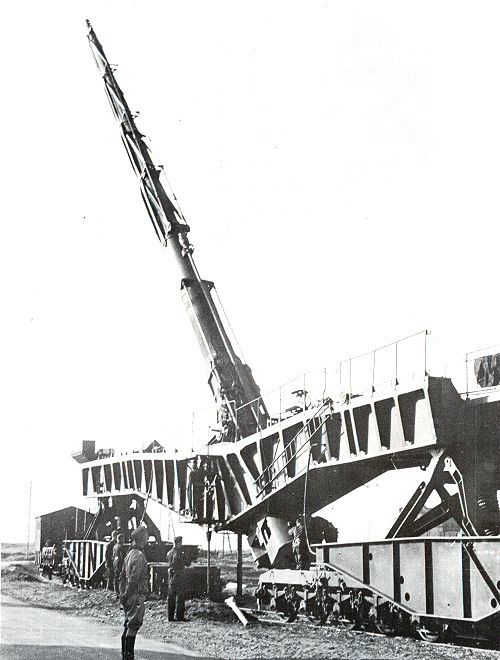 The
21cm Paris Geschütz (Paris Gun) of 1918 had been developed by Krupp at
the request of the German navy, and it was manned and controlled during
its short but spectacular life by naval personnel. During the remainder of
the 1920s and early 1930s a great deal of theoretical research work was
done, and the Vögele Drehscheibe (Portable turntable) was designed and
perfected. The
21cm Paris Geschütz (Paris Gun) of 1918 had been developed by Krupp at
the request of the German navy, and it was manned and controlled during
its short but spectacular life by naval personnel. During the remainder of
the 1920s and early 1930s a great deal of theoretical research work was
done, and the Vögele Drehscheibe (Portable turntable) was designed and
perfected.
Eventually, with all the paperwork done and the political indications
favourable, work begin on the actual gun. The great problem was to achieve
the very high velocity that would put the shell into the stratosphere,
there allowing it to travel against much less air resistance and so attain
a very long range, the same technique that had been employed with the
Paris gun. The 1918 weapon had, however, worn out at an incredible rate,
to such a degree that shells of gradually increasing diameter, serially
numbered, had to be made to suit the rate of wear.
The relatively simple box girder structure carried on two sub frames which
were in turn mounted on double bogies, the front sub frame on two
ten-wheel and the rear on two eight-wheeled bogies.
To absorb the recoil the gun was mounted in a ring cradle with a hydro
pneumatic recoil system and the mounting incorporated two more hydro
pneumatic systems connected to the two sub frames, so that the entire
girder section was capable of recoiling some 980mm (38.58") rearwards
across the sub frames. Provision was made to disconnect the gun from its
recoil system and pull the barrel back some 1500mm in the cradle, reducing
the overall length and improving the weight distribution, so that when
traveling the entire equipment was manoeuverable within the standard
loading gauge and track curvature.
The gun itself posed one or two problems. It was exceptionally long
(33.3m/1089.25 ft) and required to be braced throughout its length to
prevent it bending under its own weight. It was moreover considered
impossible to balance such a preponderance and so the trunnions were set
forward to obtain as much weight as possible at the breech.
This in turn meant that the breech came perilously close to the track when
the gun was elevated, and so it became necessary to design and install a
hydraulic jacking system to lift the whole mounting structure from the
subframe by 1.00 m (3.28 ft) before firing; this allowed the breech room
to recoil. The jacking process had to be repeated for every round, as it
was impossible to load the gun when the mounting was raised.
This weapon, completed in 1938 and issued to the army in March 1939, was
known as the 21cm K 12V. It was a success, but the complicated business
jacking it up and down between shots was not well received by the army and
the designers embarked on a major redesign. Much research was done into
the question of balancing the immerse barrel length, until it was found
that hydro pneumatic balancing presses could be made to work at much
greater weights and pressures than had previously been believed possible.
The mounting was consequently redesigned with the barrel as far forward as
possible and with a single hydro pneumatic balancing press. The whole
equipment was also made slightly longer, and the recoil stroke of the gun
mounting was increased to 1500mm (59.06 ")
Courtesy from
German Artillery of World War II - Ian V.Hogg - Greenhill Books
- ISBN 0887403220  |

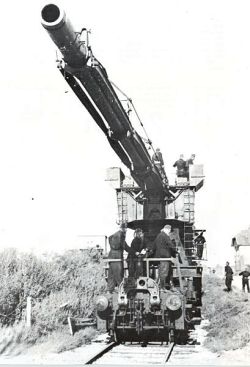
Front view of the gun being moved
into firing position.
Note also the heavy cast connecting link that attached the gun carriage to
the buffer system of the Vögele turntable. |

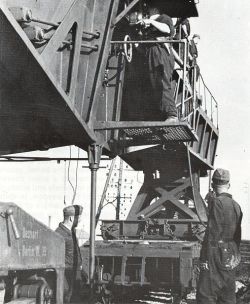
The hydraulic jacks, shown here
under the ends of the gun carriage |

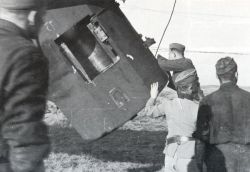
The massive, heavy breech, here
with the breechblock closed, served as a counterweight to the extremely
long barrel. The great weight of the breech assembly allowed the trunnions
to be mounted near the rear of the barrel, resulting in high permissible
angles of fire and a lower of center of gravity. |

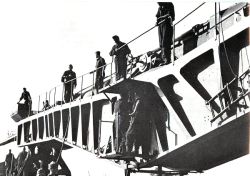
21cm K12 V in travel order |

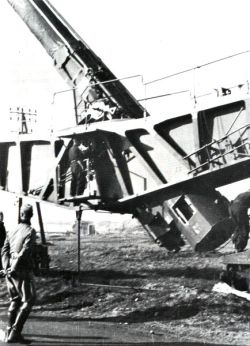
The artilleryman on the carriage
adjusts the firing mechanism prior to the command to fire, while another
crew member checks the breech. |

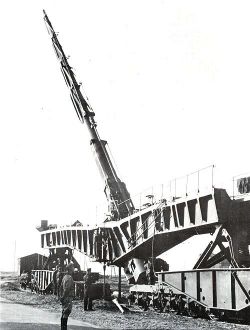 |
|
References
/ Credits :
 Deutsche Eisenbahn Geschützen - Gerhard Taube - Motor Buch
Verlag - ISBN 3-613-01352-5
Deutsche Eisenbahn Geschützen - Gerhard Taube - Motor Buch
Verlag - ISBN 3-613-01352-5 
 Die schweren Geschütze der Welt - Franz Kosar - Motor Buch Verlag
- ISBN 3-613-02204-4
Die schweren Geschütze der Welt - Franz Kosar - Motor Buch Verlag
- ISBN 3-613-02204-4 
 German Artillery of World War II - Ian V.Hogg - Greenhill Books
- ISBN 0887403220
German Artillery of World War II - Ian V.Hogg - Greenhill Books
- ISBN 0887403220 
 Eisenbahn Geschütze der Welt - Franz Kosar - Motor Buch Verlag
- ISBN 3-613-01976-0
Eisenbahn Geschütze der Welt - Franz Kosar - Motor Buch Verlag
- ISBN 3-613-01976-0 
 German Railroad Guns in action - Joachim Engelmann - Squadron
- ISBN 0-89747-048-6
German Railroad Guns in action - Joachim Engelmann - Squadron
- ISBN 0-89747-048-6  |
